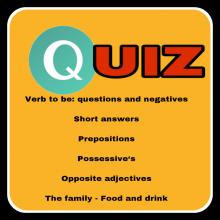- Log in to post comments

Welcome to the Family and Consumer Science test, where we explore the intricate ties of family dynamics and the delightful world of food and drink. In this examination, we will delve into questions about relationships, utilizing the verb 'to be' to express connections. Short answers will challenge your ability to concisely respond to inquiries about family and personal preferences. Be prepared to navigate the complex web of prepositions as we explore family structures and their roles. Possessives will play a key role in identifying familial ownership, and understanding opposite adjectives will add nuance to your descriptions. This test promises a flavorful journey through the tapestry of family life, enriched with the savory and sweet elements of food and drink. Best of luck!"
Verb To Be: Questions and Negatives
The verb "to be" is one of the most important verbs in English. It's used to talk about identity, characteristics, and states of being. In questions, we switch the subject and the verb, and in negatives, we use "not" to show the negative form.
- Questions: "Am I late?", "Are they ready?", "Is it raining?"
- Negatives: "I am not tired.", "They aren't at home.", "She isn't happy."
Short Answers
In conversations, we often use short answers to respond to questions quickly without repeating the full sentence. These are common in everyday English.
- Example: "Are you hungry?" – "Yes, I am." / "No, I'm not."
- Example: "Is he coming?" – "Yes, he is." / "No, he isn't."
Prepositions
Prepositions are words that show relationships between nouns or pronouns and other words in a sentence. They often indicate time, place, or direction.
- Time: "I’ll see you at 7 o'clock.", "They work on weekdays."
- Place: "The book is on the table.", "She lives in New York."
- Direction: "We are walking to the park.", "He went into the room."
Possessive 's
The possessive 's is used to show ownership or relationships. It's placed after the owner to indicate that something belongs to them.
- Example: "This is John's book." (The book belongs to John)
- Example: "It's my sister's birthday today."
Opposite Adjectives
Opposite adjectives are pairs of words that have completely different meanings. Learning these pairs helps to describe things clearly.
- Examples: hot/cold, big/small, fast/slow, happy/sad
- Example in a sentence: "The weather is very hot, but yesterday it was cold."
The Family
Talking about family in English involves knowing the different terms for family members and how to describe relationships.
- Family members: father, mother, brother, sister, uncle, aunt, cousin, grandparents
- Example: "My brother is two years older than me, and my cousin is visiting us next week."
Food and Drink
Food and drink vocabulary is essential for daily conversations, especially when talking about meals, preferences, or cooking.
- Food items: bread, rice, meat, vegetables, fruits
- Drinks: water, coffee, tea, juice, soda
- Example: "I like drinking tea in the morning, and for dinner, I usually eat chicken with vegetables."